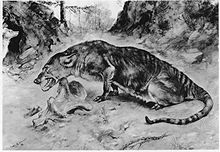- Mesonychidae
-
Mesonychids
Temporal range: Early Paleocene–Early Oligocene
Harpagolestes immanis skull Scientific classification Kingdom: Animalia Phylum: Chordata Class: Mammalia Infraclass: Eutheria Superorder: Laurasiatheria Order: Mesonychia Family: Mesonychidae
Cope (1880)[1]Genera - Ankalagon
- Dissacus
- Guilestes
- Harpagolestes
- Hessolestes
- Hukoutherium
- Jiangxia
- Mesonyx (type genus)
- Mongolestes
- Mongolonyx
- Pachyaena
- Sinonyx
- Synoplotherium
- Yangtanglestes
Mesonychidae ("Middle Claws") is an extinct family of medium to large-sized omnivorous-carnivorous mammals closely related to artiodactyls (even-toed ungulates) which were endemic to North America and Eurasia during the Early Paleocene to Late Eocene living from 65—33.9 mya, existing for approximately 31.1 million years.
Contents
Description
The mesonychids were an unusual group of condylarths with a specialized dentition featuring tri-cuspid upper molars and high-crowned lower molars with shearing surfaces. They were once viewed as primitive carnivores, like the Paleocene family Arctocyonidae, and their diet probably included meat and fish. In contrast to this other family of early mammals, the mesonychids had only four digits furnished with hooves supported by narrow fissured end phalanges. [2]
Evolutionary history
They first appeared in the Early Paleocene, undergoing numerous speciation events during the Paleocene, and Eocene. Mesonychids fared very poorly at the close of the Eocene epoch, with only one genus, Mongolestes,[3] surviving into the Early Oligocene epoch.
Mesonychids probably originated in Asia, where the most primitive mesonychid, Yangtanglestes, is known from the early Paleocene. They were also most diverse in Asia where they occur in all major Paleocene faunas. Since other carnivores such as the creodonts and condylarths were either rare or absent in these animal communities, mesonychids most likely dominated the large predator niche in the Paleocene of Asia. Throughout the Paleocene and Eocene, several genera, including Dissacus, Pachyaena and Mesonyx would radiate out from their ancestral home in Asia and into Europe and North America, where they would give rise to new mesonychid genera. These animals would have migrated to North America via the Bering land bridge.
The term "mesonychid" is often used to refer to any of the various members of the order Mesonychia, though most experts prefer to use it to refer to the members of the family Mesonychidae, with many experts using the term "mesonychian" to refer to the order as a whole.
Taxonomy
Mesonychidae was named by Cope (1880). It is not extant. Its type is Mesonyx. It was assigned to Creodonta by Cope (1880); to Creodonta by Cope (1889); to Carnivora by Peterson (1919); to Mesonychia by Carroll (1988) and Zhou et al. (1995); and to Cete by Archibald (1998).[4]
Species
Family Mesonychidae
- Genus Ankalagon
- Ankalagon saurognathus
- Genus Dissacus
- Dissacus argenteus
- Dissacus europaeus
- Dissacus indigenus
- Dissacus magushanensis
- Dissacus navajovius
- Dissacus praenuntius
- Dissacus rotundus
- Dissacus serior
- Dissacus serratus
- Dissacus willwoodensis
- Dissacus zanabazari
- Dissacus zengi
- Genus Guilestes
- Guilestes acares
- Genus Harpagolestes
- Harpagolestes immanis
- Harpagolestes koreanicus
- Harpagolestes orientalis
- Genus Hessolestes
- Genus Hukoutherium
- Hukoutherium ambigum
- Hukoutherium shimemensis
- Genus Jiangxia
- Genus Mesonyx
- Mesonyx obtusidens
- Mesonyx uintensis
- Genus Mongolestes
- Mongolestes hadrodens
- Mongolestes huangheensis
- Genus Mongolonyx
- Mongolonyx dolichognathus
- Mongolonyx robustus
- Genus Pachyaena
- Pachyaena gigantea
- Pachyaena intermedia
- Pachyaena ossifraga
- Pachyaena gracilis
- Genus Sinonyx
- Sinonyx jiashanensis
- Genus Synoplotherium
- Synoplotherium vorax
- Genus Yangtanglestes
- Yangtanglestes conexus
References
- ^ PaleoBiology Database: Mesonychidae, basic info
- ^ Agusti, Jordi; Anton, Mauricio (2002). Mammoths, Sabertooths, and Hominids: 65 Million Years of Mammalian Evolution in Europe. Columbia University Press. p. 13. ISBN 0231116403.
- ^ Jin, X. (2005). "Mesonychids from Lushi Basin, Henan Province, China (in Chinese with English summary)" (– Scholar search). Vertebrata PalAsiatica 43 (2): 151–164. http://www.ivpp.ac.cn/pdf/magazine308.pdf.[dead link]
- ^ J. D. Archibald. 1998. Archaic ungulates ("Condylarthra"). In C. M. Janis, K. M. Scott, and L. L. Jacobs (eds.), Evolution of Tertiary Mammals of North America 1:292-331
Categories:- Mesonychids
- Oligocene extinctions
Wikimedia Foundation. 2010.

